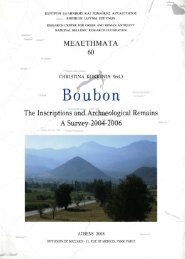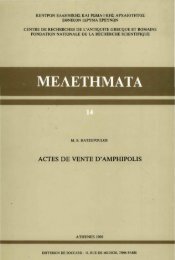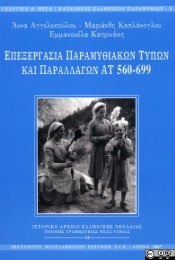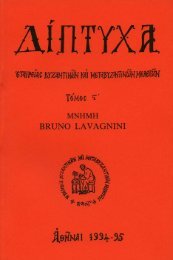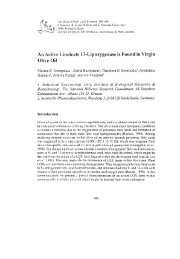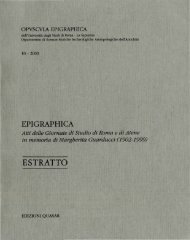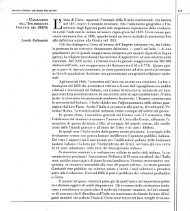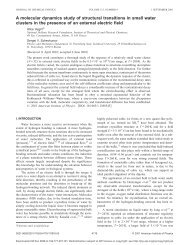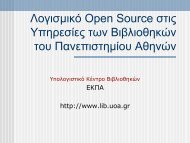roman name-formula
roman name-formula
roman name-formula
- No tags were found...
Create successful ePaper yourself
Turn your PDF publications into a flip-book with our unique Google optimized e-Paper software.
the home of legionary soldiers 61 . Roman citizens<br />
bearing the nomen Antoniuswere common in Asia<br />
Minor, a fact which makes us believe that M.<br />
Antoninus M. f. Rufus, Abretten(us) (AD 99), did<br />
not usurp his CNF. Along with the evidence<br />
analyzed supra, sections I-II, all this tends to show<br />
that the CNF recipients of diplomata for auxiliaries<br />
with an "Oriental" origo really were Roman citizens.<br />
The numerical preponderance in our list of<br />
Stobi (AD 134,179) and the cities of Cyrrhestice<br />
(AD 98,120,138) taken together seems especially<br />
significant in that respect, the more so as these<br />
centres are also known from sources other than<br />
diplomata to have enlisted auxiliaries in addition<br />
to the legionaries 62 . And, for what it is worth, the<br />
majority of the gentilicia cited in our list 63 are attested<br />
in the towns/regions to which the origines point.<br />
Negative evidence seems instructive, too. With<br />
the exception of the Abretten(o)(AO 99), the items<br />
of the catalogue omit origines which, historically<br />
and juridically, are expected to have had little or<br />
no Roman citizens ("tribes", koina, komaitt sim.).<br />
This feature of the source-material strongly<br />
contrasts with the relative multitude of (e.g.)<br />
Thracians among the PNF recipients of auxiliary<br />
diplomata. Moesia (Inferior) and Thrace had only<br />
several communities constituted from, or containing<br />
considerable numbers of, Roman citizens in<br />
the first and second century A.D. Thence so many<br />
Thracians are found in the PNF group and (so far)<br />
none in the CNF group. This picture has been made<br />
more complete by M. P. Speidel's attentive analysis<br />
of the evidence concerning the auxiliary recipients<br />
of diplomata from Latin-speaking provinces. That<br />
scholar has remarked "that in the West every time<br />
atown is given as a soldier's home, the man carries<br />
the tria nomina. One may be tempted, therefore,<br />
to infer that a soldier's tria nomina in the West, at<br />
least, tend to suggest Roman citizenship" 64 . Under<br />
the influence of Mócsy's theory, Professor Speidel<br />
resisted that temptation, but the concordance of<br />
the "West" and "East" on the point in question is<br />
too marked to allow us to suppose that among the<br />
CNF aere incisi from auxilia there were cryptoperegrines<br />
in any numbers worthy of mention.<br />
If the main conclusion of the present parer is<br />
accepted, it suggests two interconnected observations<br />
of broader interest.<br />
40<br />
S. DUSANIC<br />
First, regarding the legal aspect of the occurrence<br />
of Roman citizens among the recipients of auxiliary<br />
diplomata. The share of such people in the class of<br />
the auxiliary aere incisimust have been considerable<br />
under the Flavian dynasty, and increasing in<br />
the second century; thence the qui eorum non<br />
haberent modifier will be introduced c. AD 140.<br />
What was the purpose of giving them documents<br />
about privileges when the main one, civitasRomana,<br />
was already possessed? That question, long<br />
debated, used to be answered by modern historians<br />
to the effect that if the aere incisi did not need<br />
civitas for themselves, they could still need the ius<br />
conubii and/or civitas for their children, i.e. the<br />
61. Ibid., 344 with notes 185f., 346 note 197; cf. 347.<br />
Stobi became a municipium early in Vespasian's reign, if<br />
not before, and obtained the ius Italicum at an uncertain<br />
date not later than Elagabalus (F. Papazoglou, Les villes<br />
de Macédoine à 1 ' époque romaine [Paris 1988] 313ff.). It<br />
was probably never a colonia civium Romanorum.<br />
62. For the coh. II Cyrrhestarum (the numeral implies<br />
the existence of a coh. I Cyrrhestarum, too) see Saddington<br />
(supra, note 17) 163. At least three Stobians were<br />
soldiers of the coh. IHispanorum veterana underTrajan,<br />
to judge from the papyrus referred to (supra, note 41 : col.<br />
Ilines 13,16,18f.). At a time when that papyrus and RMD<br />
123 were unknown as yet, Mommsen (Ges. Sehr. VI 62<br />
note 6) thought that, for the auxiliaries, the home indications<br />
citing the cities of Stobi's rank had been anomalous. This<br />
verdict did not take into account the process of levelling<br />
the auxilia and the citizen troops, a process which went<br />
rather far by the end of the first century AD (cf. supra, notes<br />
2,20,24).<br />
63. They are not rare enough to allow useful rapprochements.<br />
The gentile of the recipient of XVI78 (AD 134)<br />
could be an exception, but he is (so far) the only Sextilius<br />
evidenced in Stobi (the <strong>name</strong>s of his sons Valerius and<br />
Petronius, and his daughter Annia, were derived from the<br />
gentilicia—quite common, it is true—which are evidenced<br />
in the prosopography of the city: F. Papazoglou, Chiron<br />
16 [1986] 233 and 235). Let us note, however, that the M.<br />
Antonii (AD 99; 120; 122) are quite common among the<br />
cives Romani attested in Syria and Asia Minor, and that<br />
some Cas(s)ii (AD 93) occur in the inscriptions of Larisa<br />
(IGX.2,828; cf. 550, line 2). For the Insteius (AD 98) and<br />
Ulpius (AD 179) see supra, notes 39 and 41.<br />
64. RMDHQ 478. Cf. Mommsen, Ges. Sehr. VI 44f.



